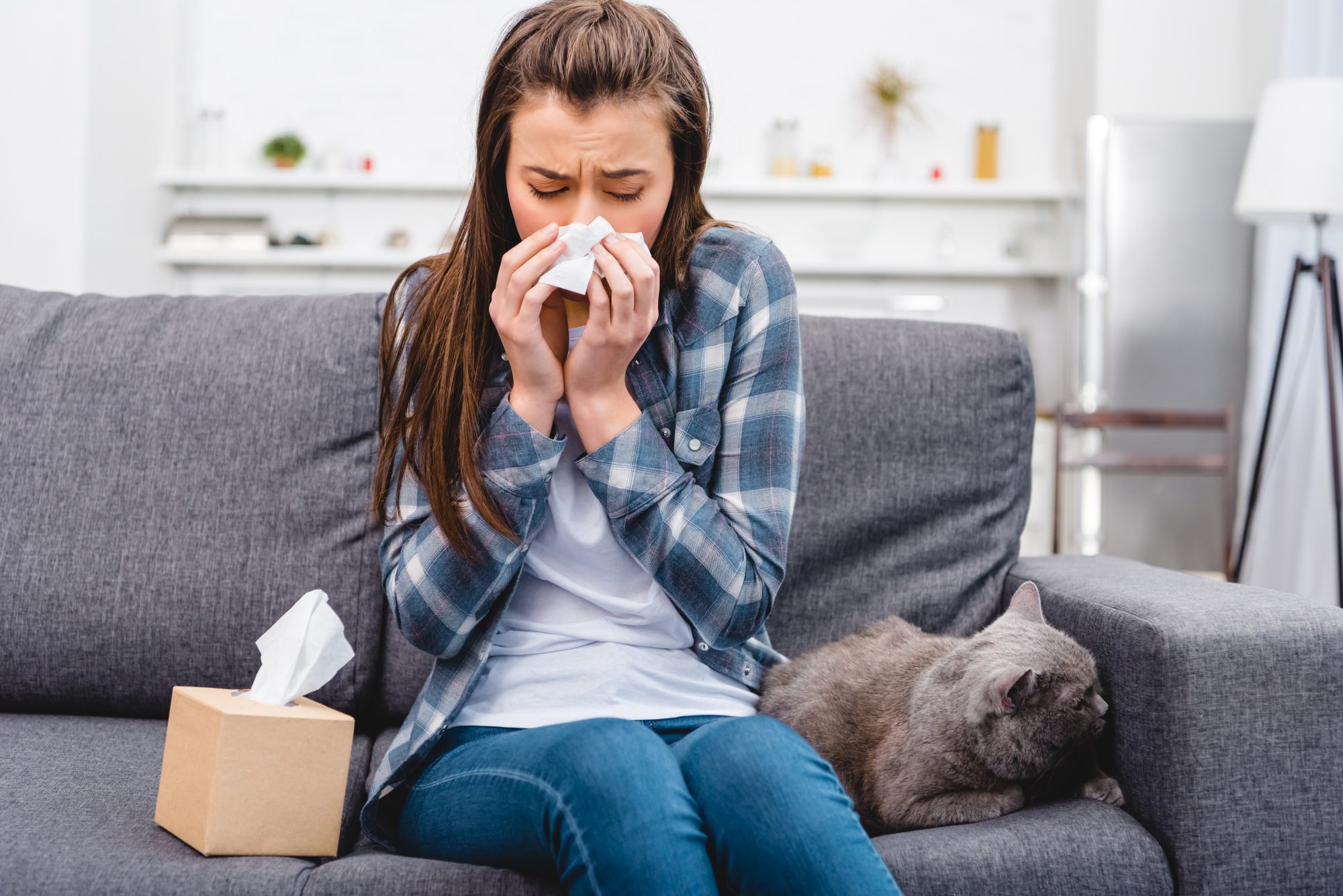
Are you a cat parent who can’t stop sneezing when you’re around your cat? Do you avoid going to a friend’s house because they have a cat that makes your eyes water? If so, this article is for you.
In a game-changing study, Purina has found a novel way to help people who are allergic to cats—through a cat’s diet. Purina’s researchers formulated a special cat diet that reduces Fel d1, the cat allergen most responsible for causing allergies to cats. Further study will be done before the cat food is commercially available.
Before delving into how this diet works, let’s first talk about allergies to cats and Fel d1.
What are Allergies to Cats?
If you’re a part of the 20 percent of people who are allergic to cats, you’re well-acquainted with allergy symptoms like sneezing, watery eyes, and hives. These symptoms range from mild to severe and depend on a person’s sensitivity to Fel d1 and their level of exposure to the allergen. Allergy symptoms can develop gradually or as soon a person comes anywhere near a cat.
To date, allergy management strategies have included getting allergy shots, spending less time around a cat or, even more extreme, removing a cat from the home. For cat parents, it can be upsetting to think about cutting down on quality time with their beloved cat or giving their cat away.
What’s Fel d1?
Fel d1, the allergen culprit in 95 percent of all allergies to cats, is primarily found in a cat’s saliva but can also be found in dander (dead skin cells) and urine. When a cat grooms itself, Fel d1 is transferred from the saliva to the hair. Shedding releases Fel d1 into the air. Because Fel d1 is tiny, it can linger in the air for hours or even months; thus, a person’s allergies can flare up even when a cat is not in the room.
Not only can this allergen linger in the air, but it can also cling to furniture and clothes, making its removal from the environment quite challenging.
Purina’s solution was to prevent Fel d1 from being released into the environment in the first place. Let’s look at how Purina did this:
Purina’s Solution
One word: chickens. But not just any chickens—chickens who share an environment with cats. These chickens have antibodies against Fel d1; antibodies fight foreign substances in the body. These anti-Fel d1 antibodies, which the chickens naturally produce and transfer to their eggs, neutralize Fel d1 in a cat’s saliva and reduce the amount of “active” Fel d1 on a cat’s hair. Pretty cool, right?
In a study of 105 cats, Purina formulated a special diet that contained anti-Fel d1 antibodies extracted from chicken eggs. Cats ate this diet for three months, during which time the researchers periodically collected hair samples to measure the amount of Fel d1 on the cats’ hair. They compared this amount to Fel d1 levels on the hair before the cats adopted the diet.
Here’s what they found:
- Before eating the special diet, Fel d1 levels on the hair varied greatly between cats.
- On average, eating the diet reduced Fel d1 levels by 47%.
- Cats with the highest Fel d1 levels at the start of the study had the largest decrease in levels after eating the diet.
In a related study, Purina exposed people with sensitivity to Fel d1 to hair and dander from cats who ate the special diet and cats who ate a regular diet. The people’s allergy symptoms were much less severe with exposure to the hair and dander from cats eating the special diet.
What Does it All Mean?
Purina’s new diet is welcome news for people who suffer from allergies to cats. Reducing Fel d1 through a cat’s diet could revolutionize the management of allergies to cats, allowing cat parents to spend more quality time with their cats and avoid considering allergy shots or giving up their cats.
Before you start looking for this particular diet, take note of a few things. Remember that the diet cut Fel d1 levels by about half; this reduction may not be enough for people with severe allergies. Also, the 50 percent reduction means that the allergen is still being released into the environment; it just may take longer for enough to accumulate to trigger an allergic reaction.
Purina will conduct more studies on the diet before making it commercially available for cat parents.
What Can You Do?
If you’re a cat parent who is allergic to cats, continue with your current allergy management plan. Visit Purina’s website to learn more about their dietary breakthrough.
Content provided by JoAnna Pendergrass, DVM. Dr. Pendergrass is owner and founder of JPen Communications, a medical communications company specializing in consumer education.








